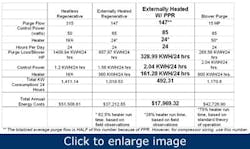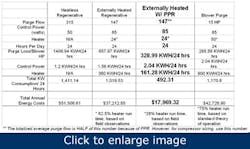Thousands of dollars saved with pulse purge regeneration
From the dawn of the 20th century, compressed air has proven to be a valuable utility to general industry. Often regarded as a “free” energy source, compressed air systems have become the backbone of many modern production facilities.
But compressed air is the most inefficient source of energy in modern manufacturing. It takes approximately eight cubic feet of atmospheric air to make one cubic foot of compressed air at 100 psig. It is expensive, high-maintenance and frequently, production systems cannot run without it. In today’s changing energy climate, industry cannot afford to ignore these inefficiencies any longer.
[pullquote]In terms of air treatment, the majority of facilities can operate sufficiently with refrigerated air dryers, which generally offer dew point performances from 34-50°F; pressure dew point (PDP) depends on the manufacturer and type of refrigerated dryer. Some systems and processes require a much lower dewpoint, which requires the use of regenerative desiccant drying systems. These often use large volumes of expensive compressed air to dry the desiccant.
Traditional regenerative dessicant dryer control schemes, such as dew point demand, can only save energy when the dryer is not operating at 100% capacity. But one approach, called pulse purge regeneration (PPR), offers energy savings under all operating conditions, including full load at 100% capacity.
PPR works by disrupting the continuous purge flow that a standard externally heated dryer would have. In a 1,000 cfm dryer, a standard externally heated dryer uses 70 SCFM for regenerative purge and is flowing constantly. With pulse purge regeneration (PPR), the dryer purges at the same rate, but only for a portion of the cycle. In the PPR cycle, the purge flow alternates between being pressurized with heated dry air and depressurization/purge flowing. While the desiccant tower is pressurized, compressed air is not being used for purge resulting in an energy savings. There are three main benefits to doing this:
- By pressurizing the tower, heated dry air is allowed a longer contact time in the system and can more effectively “pull” (desorb) moisture out of the wet desiccant bed.
- Instant depressurization of the desiccant bed aids in regeneration. The rapid depressurization of the desiccant bed forces the captive moisture out of the system more forcibly than the low pressure purge flow alone. A standard externally heated dryer would only do this one time during a regeneration cycle. A dryer with PPR will do this multiple times during the regeneration cycle.
- When the purge valve is closed and the regenerating tower is at line pressure, there is no pressure gradient to cause purge air to flow. During this time, 100% of the inlet air is available for use by the compressed air system, but more importantly, air is not flowing over the thermostatically controlled heater element. When it comes up to full temperature, it will turn off, eliminating significant energy consumption. Because the heater shell is also properly insulated, it will stay at full temperature long enough to realize significant energy savings. Extensive field observations of systems with PPR have found that the typical running time of a heater is 28% compared to 75% in some dryers. With the additional part load efficiencies created by dewpoint demand, this number typically drops to an average of 18% heater run time.
The PPR control scheme has been patented by Pneumatech, and can be applied to any make or model of regenerative dryer.
PPR case study
In January of 2008, a chemical plant In Lockport, N.Y., purchased and installed a Pneumatech model PE-2100. The dryer was purchased to replace a competitive heatless dryer of similar size. The customer has a total of three compressors; two 150 HP load/no load compressors as well as a 100 HP compressor retrofitted with a variable frequency drive.
Pneumatech also supplied a ConservAIR K-2600 Intermediate Control and a SM-812 Sequencer to control the compressors based on the projected lower requirement for compressed air. The distributor also supplied a 2,200 gallon wet air receiver and a 6,000 gallon dry air receiver.
In order to qualify for energy rebates, the New York State Energy Research and Development Authority (NYSERDA) required a proposal that outlined projected energy savings. The dryer projections are below:
Although the projections focus on just PPR, the dryer was also ordered with dew point demand controls.
The result of the installation was a massive reduction in the amount of air and energy used in the compressor room. The dryer is currently running 61% in demand mode, and the heater run time is 15%, resulting in an actual and realized energy savings of $40,841.61 compared to a comparably sized heatless dryer. Additionally, because of the lower purge demand, the customer was able to shut off one of the 150 HP compressors, saving an additional $68,000 per year.
The requirement for low dew point air is ultimately dictated by the process or application. Often, it is tempting to supply a solution that offers the lowest possible initial investment. However, a significant look at life-cycle cost should guide the purchase of any compressed air equipment.

